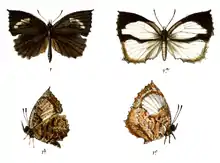Allotinus drumila
Allotinus drumila, the crenulate darkie,[1] is a small butterfly found in India (Assam, Sikkim), Burma, Thailand, Laos, Vietnam, and Yunnan (China) that belongs to the lycaenids or blues family.
| Crenulate darkie | |
|---|---|
 | |
 | |
| Scientific classification | |
| Domain: | Eukaryota |
| Kingdom: | Animalia |
| Phylum: | Arthropoda |
| Class: | Insecta |
| Order: | Lepidoptera |
| Family: | Riodinidae |
| Genus: | Allotinus |
| Species: | A. drumila |
| Binomial name | |
| Allotinus drumila (Moore, [1866]) | |
| Synonyms | |
| |
Description
Male upperside: earthy brown. Forewing: costa at base and a broad outward discal streak from beyond apex of cell curved downwards towards but not reaching the tornal angle, dull white, diffuse at the edges; apex and termen broadly very dark blackish-brown. Hindwing: costal margin above the subcostal vein and in a line with it up to the termen similarly very dark blackish-brown, the rest of the brown colour uniform without any white. Underside, forewing: dull pale brown, costal margin and disc mottled with small catenulated spots of dark brown; cell with three short transverse bars of dark brown, the middle bar extended below the cell but not reaching the dorsum; a white curved discal band as on the upperside, but obscure, diffuse and ill-defined, merged with a pale area along the middle of the dorsum; termen broadly margined with dark rusty brown that has more or less of a mottled appearance. Hindwing: dull pale brown thickly mottled with catenulated spots and strigeo of dark rusty brown; catenulated, somewhat broken, transverse irregular bands of the latter colour cross the base, middle and apex of the cell; a similar short band is placed at right angles to the dorsal margin and curving slightly upwards terminates at vein 3. Antennae dark brown; head, thorax and abdomen rusty brown; beneath: the palpi, thorax and abdomen narrowly whitish.
Female upperside: white. Forewing: apical, terminal and tornal areas black, the inner margin of the black commences just before the middle of the costa, and runs obliquely outward in a sinuous curve to base of the apical fourth of vein 2, thence it is produced for a short distance inwardly along that vein and terminates at the middle of the dorsal margin. Hindwing: a broad black stripe along the costal margin; the termen somewhat narrowly pale yellowish-brown. Underside white, the markings somewhat variable. Forewing: costa, apex and termen with minute earthy-brown speckles, sparse along the costa, more dense on the termen; on the latter they coalesce and form a brown smudgy border that is bounded on the inner side by a curved, postdiscal, more or less clearly defined, narrow, yellowish-brown band; cell crossed transversely by a basal, a medial and an apical short similar band; the medial band darkened in colour and continued almost to the dorsum, the apical band along the discocellulars. Hindwing: with minute brown speckles, more or less lightly and irregularly stained with rusty brown; basal half with obscure, transverse, narrow, macular, earthy-brown bauds that are well-defined only anteriorly, the basal one produced up to the dorsum; a short dark-edged transverse band from the tornus to vein 4 running parallel to the costal margin, the lower edge of the band acutely and irregularly dentate; the terminal and tornal areas below this band washed with earthy brown. Antenna, head, thorax and abdomen as in the male but very much paler.[2]
Cited references
- Page on Markku Savela's site for genus Allotinus (Lycaenidae).
- Bingham, C.T. (1907). The Fauna of British India, Including Ceylon and Burma. Vol. II (1st ed.). London: Taylor and Francis, Ltd.
References
- Bingham, C.T. (1907). The Fauna of British India, Including Ceylon and Burma. Vol. II (1st ed.). London: Taylor and Francis, Ltd.
- Evans, W.H. (1932). The Identification of Indian Butterflies (2nd ed.). Mumbai, India: Bombay Natural History Society.
- Wynter-Blyth, Mark Alexander (1957). Butterflies of the Indian Region. Bombay, India: Bombay Natural History Society. ISBN 978-8170192329.
Online
- Beccaloni, George; Scoble, Malcolm; Kitching, Ian; Simonsen, Thomas; Robinson, Gaden; Pitkin, Brian; Hine, Adrian; Lyal, Chris. "The Global Lepidoptera Names Index (LepIndex)". Natural History Museum, London. Retrieved 2016-10-15.
- "Markku Savela's website on Lepidoptera".